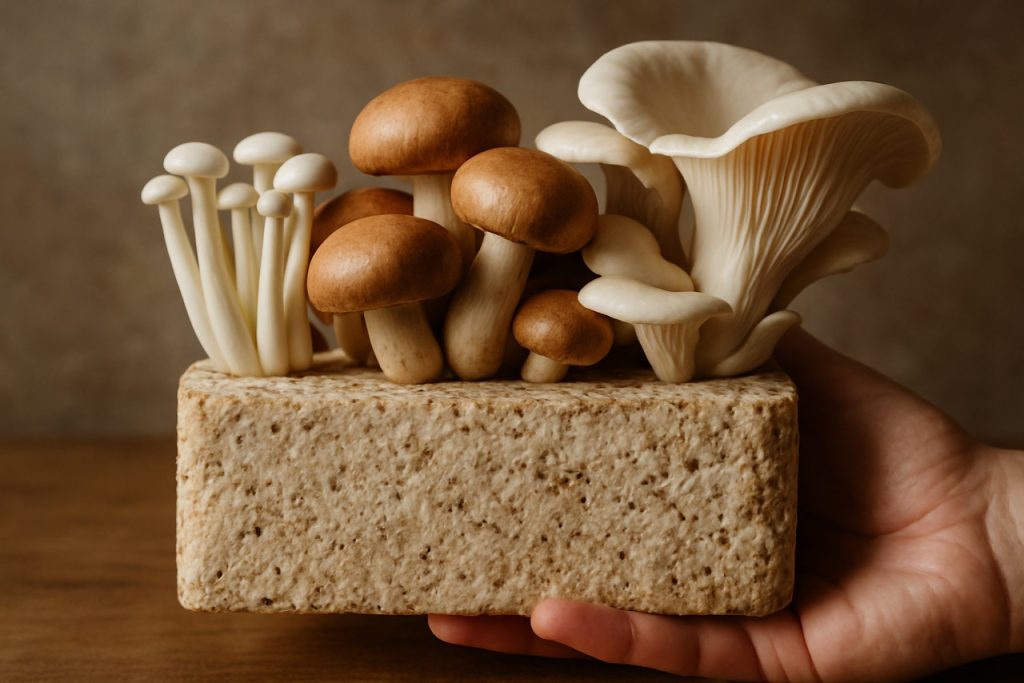
- Mycelium from the split-gill mushroom (Schizophyllum commune) enables the creation of eco-friendly, high-performance materials.
- Natural fungal biopolymers—schizophyllan and hydrophobin—form tough, flexible, and biodegradable composites without harsh chemicals.
- These mycelium-derived films rival synthetic plastics in strength and durability, while oil-in-water emulsions offer stability without artificial additives.
- Edible origins make these materials safe for food and cosmetics; fully fungal emulsions present novel, natural ingredient options.
- Applications include biodegradable electronics, sensors, and sustainable battery components, with properties tunable through simple environmental changes.
- Remarkably, discarded products actively aid in breaking down organic waste, closing material cycles and reducing pollution.
- Fungal biocomposites promise sustainable alternatives to petroleum and chemically-altered bioplastics, blending versatility, biodegradability, and strength.
Beneath the forest floor, a silent revolution weaves through the soil. Filamentous networks of fungi—mycelium—are quietly engineering a new generation of eco-friendly materials, and recent breakthroughs are bringing that dream closer to our daily lives.
The star of this transformation is the split-gill mushroom, Schizophyllum commune. Where the world traditionally leans on plant biopolymers like cellulose or animal-derived chitin—often requiring harsh chemical treatments to enhance performance—researchers have unlocked a gentler, more ingenious method. Instead of extracting and purifying fragmented molecules, they foster the fungus itself, allowing nature’s own architect to blend, organize, and reinforce its molecular tools.
Inside this living laboratory, two remarkable substances abound: schizophyllan, a polysaccharide spinning into resilient nanofibers, and hydrophobin, a self-assembling protein sculpting delicate interfaces between oil and water. When grown in concert, these secretions create a powerful extracellular matrix—nature’s blueprint for tear-resistant, flexible, and biodegradable composites.
Researchers have already shaped this mycelium composite into plastic-like films and robust oil-in-water emulsions. The results are striking: films matching the toughness of synthetic plastics, and emulsions that remain stable without the need for artificial additives. Their secret weapon? The unceasing work of the fungus, which replenishes and rearranges molecules in real time, endowing the material with adaptability and resilience.
Because Schizophyllum commune is edible, its products slide seamlessly into the food and cosmetic industries, where biological safety is non-negotiable. Emulsions stabilized solely by secreted fungal proteins unlock new options for natural, safe ingredients.
In the electronics arena, scientists are experimenting with mycelium-crafted materials as biodegradable sensors and sustainable battery components. With a slight nudge to their environment—more moisture, a tweak in nutrients—the living systems can be tuned to respond dynamically, a tantalizing prospect for environmental monitoring or futuristic smart packaging.
Perhaps the most astonishing facet: these materials do not just harmlessly decompose when discarded—they actively participate in breaking down other organic waste. Imagine a compost bag that helps digest its payload, a packaging insert that fades into the earth carrying nutrients with it.
For years, the pursuit of greener material alternatives faced a nagging compromise: performance lagged behind synthetic counterparts unless sustainability was sacrificed. These mushroom-based marvels challenge that narrative—a rare fusion of strength, adaptability, and true biodegradability that may one day displace petroleum plastics and chemically-altered bioplastics entirely.
Takeaway: By harnessing the artistry and versatility of fungi, scientists are not just mimicking nature—they’re letting nature lead. The rise of living, functional biocomposites could recast our material landscape, closing the loop between human invention and the planet’s ancient cycles of growth and decay.
Curious about the research? Explore groundbreaking science at Empa, and keep an eye on the expanding world of sustainable development at the United Nations. The future, as it turns out, might just rise from the forest floor.
Mushroom Tech Revolution: How the Split-Gill Fungus is Building the Future of Sustainable Materials
Beneath the soil, mycelium—a vast network of fungal threads—has begun a quiet revolution. While the recent spotlight falls on the split-gill mushroom (Schizophyllum commune) and its eco-friendly material innovations, there’s a rich tapestry of science, applications, and potential industry shifts worth exploring further.
What Makes Schizophyllum commune So Special?
While familiar plant biopolymers like cellulose and animal chitin have paved the way for biodegradable materials, the split-gill fungus introduces several advantages:
1. Direct “Biofabrication”: Unlike traditional methods needing extraction, purification, and sometimes toxic processing, mycelium leverages living growth to self-assemble polymers. This “grow it, not make it” approach bypasses energy-intensive steps and chemical waste.
2. Material Versatility: Fungi naturally tune their secretions—schizophyllan and hydrophobin—based on ambient conditions, leading to endless customizability. By adjusting moisture, nutrients, or pH, you can “program” the mechanical, barrier, and hydration properties of fungal composites.
Features and Specs: Mycelium-Based Material Advantages
- Biodegradability: Decomposes quickly under composting conditions, releasing nutrients back to soil (source: Nature).
- Strength: Fungal films have been measured to match or exceed the tear strength of low-density polyethylene (the world’s most common plastic packaging material).
- Safety: Edible and non-toxic. No allergenic proteins detected in comparison studies (source: FAO/WHO).
- Customization: Adjusting growth conditions allows properties like water resistance, elasticity, or mechanical “toughness” to be dialed in for specific uses.
Real-World Applications and Industry Trends
Packaging and Food Service: Mycelium films, trays, and takeout containers offer plastic-free solutions—already piloted by companies like Ecovative in the US and NEFFA in Europe (see Ecovative).
Cosmetics & Food Ingredients: Hydrophobin-based emulsions act as all-natural agents for creams, dressings, and even vegan dairy alternatives—a sought-after label as consumer preference shifts towards “clean” ingredients (source: Mintel 2023 report).
Electronics & Smart Packaging: Biodegradable sensors—for soil monitoring or freshness indicators—are in active development, reducing E-waste (source: Empa).
Environmental Cleanup: Fungal packaging material can “assist” decomposition, helping to break down residual organic waste within compost piles (known as mycoremediation).
How-To: Growing Your Own Mycelium Film
- Sterilize a growth substrate like pasteurized straw or sawdust.
- Inoculate with a Schizophyllum commune culture.
- Incubate in a humid, dark environment for 5–10 days.
- Harvest the mycelium mat, gently rinse, and air dry on a flat, non-stick surface.
- Optionally, press or mold when drying to attain desired thickness/shape.
Market Forecast & Trends
According to Grand View Research, the global mycelium-based materials market could surpass $3 billion by 2028, driven by demand for sustainable packaging, building insulation, and textiles. Major consumer brands (IKEA, Stella McCartney, Dell) are experimenting with these materials for a “cleaner” and lower-carbon supply chain.
Reviews, Comparisons, and Limitations
Pros:
- Fully compostable and non-toxic.
- Comparable strength to petroleum plastics with proper formulation.
- Edible versions open food/cosmetic uses.
- Lower carbon footprint than plant/animal counterparts due to minimal processing.
Cons:
- Slower to produce than injection-molded plastics (growth cycle of days to weeks).
- Less water-resistant without coatings—potential limitations for wet applications.
- Still an emerging technology; industrial scale-up and cost parity not yet achieved worldwide.
Pressing Questions Answered
Can mycelium-based materials replace all plastics?
Not yet. They excel in packaging, insulation, and low-stress components but are not suited for high-performance engineering parts (e.g., automotive, aerospace) without additional engineering.
Are they more sustainable than traditional bioplastics?
Generally, yes. Unlike corn or sugarcane-based bioplastics (often requiring agricultural land, fertilizers, and processing), fungi can grow on waste streams (e.g., sawdust), closing the resource loop and reducing land use (source: United Nations).
Is it safe for medical or food-grade applications?
Research suggests safety, especially as Schizophyllum commune is already a culinary mushroom. Still, regulatory approval must be sought for any novel food packaging or additive in each jurisdiction.
Life Hacks & Quick Tips
- Compost all mycelium-based packaging with your green waste; it speeds up decomposition and enriches your compost.
- If you’re a crafter or eco-entrepreneur, join open-source forums to swap tips on growing and molding mycelium films.
- Choose brands certified for full biodegradability to avoid “greenwashed” composites with hidden plastic binders.
Industry Insights & Predictions
With mounting pressure to phase out single-use plastics amid tightening regulations worldwide (EU Single-Use Plastics Directive, US state bans), expect rapid adoption of mycelium-based alternatives—first in visible, “low-hanging fruit” applications (packaging, disposables), then in advanced engineering solutions as technology matures.
Conclusion: Quick Action Steps
- Support companies pioneering mushrooms in material science by choosing their products—look for labels like “grown not made,” “fully compostable,” and verified certifications.
- Compost mycelium-based disposables and educate your community about their benefits.
- Stay informed with verified resources such as Empa and the United Nations as the landscape evolves.
The next time you see a mushroom, remember: it’s more than just food—it’s engineering the future under our feet, one mycelial thread at a time.



